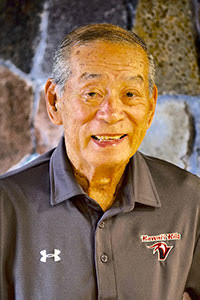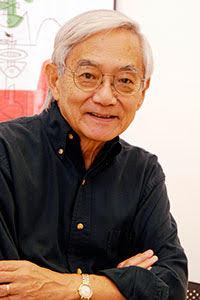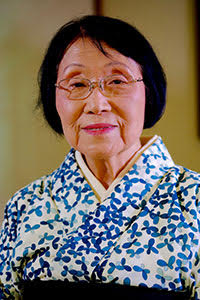Living Treasures of Hawai‘i to Be Honored
He’s a social conciliator and perpetuator of Hawaiian culture. She’s a master teacher of Japanese classical dance. One is a legendary coach who teaches character on and off the courts, while the other is a premiere architect and pioneer of environmental design.
These are the hallmarks of the four individuals who have been chosen as this year’s Living Treasures of Hawai‘i.
The 44th Living Treasures of Hawaii Recognition Program and Gala Luncheon will be held on Saturday, Feb. 9, 2019, 11 a.m. in the Coral Ballroom at the Hilton Hawaiian Village Waikiki Beach Resort.
The “Living Treasures of Hawaii” program was created by the Honpa Hongwanji Mission of Hawaii in 1976, inspired by the Living National Treasures of Japan. Bishop Yoshiaki Fujitani started the program at the suggestion of the late Paul Yamanaka, a local insurance executive, who wanted to honor those unique to the islands who demonstrate excellent and high standards of achievement in their particular fields and continue to make a significant contribution towards enriching our society.
The following individuals have been chosen as the 2018 Living Treasurers of Hawaii:

James “Jimmy” T. Yagi. PC: Living Treasures of Hawaii
James “Jimmy” T. Yagi
It’s been said that sports do not build character, they reveal it. In the case of James “Jimmy” Yagi, for most of his life, through sports he has been helping to bring out the best qualities in those he coaches.
In his 60 years teaching basketball, Coach Yagi has earned numerous awards and honors, but the greatest accomplishment may be the impact he has made on the lives of others.
In his field of basketball, Coach Yagi was the first collegiate Japanese-American head coach. During his 18 year tenure at the University of Hawai‘i at Hilo, Coach Yagi led the men’s basketball team to three District title wins and playing in three NAIA National Championships. The Vulcans averaged 23 wins per season and he remains the winningest men’s basketball coach in UH Hilo history amassing a career record 250 wins.
As a NAIA District II Coach of the Year and a member of the UH-Hilo Athletic Hall of Fame, Coach Yagi’s success is evident. However, his legacy is his development of youth basketball camps and clinics across the state that teach the game and life lessons to thousands of students and coaches alike. Over the last four decades, Coach Yagi has been involved in more than 150 camps and clinics, attracting tens of thousands of kids ages 8 to 18. As a Coach, he emphasizes respect and playing the game the right way. By teaching the fundamentals of basketball and honing these skills on the court, it is his belief that these same skills would be carried over in their personal life.
At age 83, he continues to make a significant impact on Hawai‘i’s youth and community. He recently led and participated in the 43rd Annual Jimmy Yagi Hoops Camp in Hilo. He is also an active member of the Rotary Club of Hilo where he has been a member for over 50 years. Coach Yagi continues to have a role in shaping the youth at the collegiate level by establishing a UH Hilo scholarship program honoring both his and his wife’s parents.
John Wooden is quoted as saying “a good coach can change a game, a great coach can change a life.” Coach Yagi is a living example of what all coaches aspire to be.

John M. Hara. PC: Living Treasures of Hawaii
John M. Hara
Even if you may not know his name, you know John Hara by the contributions he has made in shaping Hawai‘i’s landscape. For more than four decades, Hara has been contributing to Hawai‘i’s architecture with designs that are culturally sensitive and environmentally conscientious. In that period, Hara has completed the design and construction of over 65 complex public, academic, and cultural facility buildings for clients such as the Honolulu Museum of Art, the Maui Arts & Cultural Center, University of Hawai‘i at Hilo, University of Hawai‘i at Mānoa, the University of Hawai‘i at West O‘ahu, Punahou School, Kamehameha Schools and the Mid-Pacific institute. Since 1974, Hara’s buildings have won over 55 “Excellence in Architecture” and other design industry awards.
Hara’s devotion to the environmental, social, and cultural sustainability of his architectural designs as an essential public responsibility is demonstrated by his award-winning Case Middle School on the Punahou School campus. Case Middle School was the first major certified “green” project in Hawai‘i, attaining LEED Gold certification.
Believing that the professional responsibilities of an architect extend well beyond design and practice, Hara shares his knowledge by teaching at the University of Hawai‘i, being a mentor to students, and serving on a number of boards and organizations. Evidence of his deep commitment to the arts and culture, Hara, who was formerly a professional oboist, was appointed as the Chair of the Hawai‘i State Foundation on Culture and the Arts. He has also served on the boards of the Hawaii Youth Symphony Association, the Hawaii Opera Theater, and the Hawai‘i Public Broadcasting Authority. He is also a member of the Japanese-Hawaii Economic Council, and the Japanese Cultural Center Hawaii Advisory Board, and continues to take an active role in the preservation of the Honouliuli Internment Camp, lending his expertise to the State Advisory Committee on Honouliuli.
In 2006, Hara was the first architect ever awarded the prestigious Governor’s Award for Distinguished Achievement in Culture, Arts, and Humanities from the Hawai‘i State Foundation on Culture and the Arts.
His unique and irreplaceable contribution in the arena of architecture articulates Hara as a cultural resource throughout Hawai‘i.

Earl Kawa‘a. PC: Living Treasures of Hawaii
Earl Kawa‘a
Earl Kawa‘a has distinguished himself in the community as a teacher, peacemaker and a leader who enriches the lives of others.
Born and raised in Halawa, Moloka‘i, Kawa‘a remains one of only 28 known native speakers of the Hawaiian language. His deep connection to the land and culture are the essence of his teachings of discipline and responsibility that underlies the Hawaiian traditions. With a conviction that traditional Hawaiian culture was eroding, he began a mission to provide a “board and stone in every home.” Believing strongly in the importance of “family,” much of his work utilizes Hawaiian culture as a venue from which to teach about empowerment, family resiliency, sustainability, and commitment. The result is a meaningful, shared, and often life-changing experience through carving poi boards and stone pounders and pounding poi. More than 2,000 individuals and families have benefited from his Board and Stone classes over the last 10 years.
His early years as a social worker and community organizer continue to show through his work today. Kawa‘a is recognized for his skills in ho’oponopono, or conflict resolution, and is sought out for his expertise to settle major disputes with dignity and fairness.
Beyond working at Kamehameha Schools as a curriculum specialist, Kawa‘a volunteers with various non-profit Hawaiian organizations. He was instrumental in planning ahupua‘a scenarios for Hui Malama O Ke Kai, a youth development organization in Maunawili Valley. Internationally, he served as the expert and spiritual leader of the Daisen project, a cultural and economic exchange program between young leaders of Hawai‘i and Daisen City of Tottori Prefecture in Japan. He also contributes to building Native Hawaiian hale, most recently on the grounds of Kawaiha‘o Church.
Kawa‘a is considered by many as a gift to Hawai‘i and its culture, and a significant force in its cultivation and perpetuation.

Gertrude Tsutsumi. PC: Living Treasures of Hawaii
Gertrude Yukie Tsutsumi
For more than five decades, Gertrude Yukie Tsutsumi has been committed to preserving and sharing the traditional Japanese art Nihon Buyo in Hawai‘i, a dance form that developed in the 17th century with roots in Kabuki and Noh.
Her lifetime of dancing started at the age of eight, training under the late Bando Mikayoshi (Yoshiko Hara). Her dedication to the art was evident early on when she enrolled in college courses related to Japanese traditional performing arts at Waseda and Sophia Universities in Tokyo. The Hawai‘i-born graduate student was required to write a thesis in Japanese on Japanese theatre. Her studies enabled an intelligent understanding of the late Professor Masakatsu Gunji’s teachings, a well-published and highly respected professor of Japanese theatre. In 1953, she was bestowed the natori (professional name) of Onoe Kikunobu and nine years later opened her own school in Honolulu. As of 2014, thirteen students under her tutelage have been recognized with professional names. While widely respected as a master artist and teacher, Tsutsumi continues to hone her craft by traveling to Japan to consult and study with dance masters.
Her professional teaching career began with the State Department of Education and continued with the University of Hawai‘i at Mānoa’s Department of Theatre and Dance until her retirement in 2014. She continues to teach through her school, Kikunobu Dance Company, where Tsutsumi stresses the importance of building self confidence and building camaraderie. She believes this helps to develop a strong foundation upon which each student will be able to gradually enhance his or her own skills in performance and in life.
Always the educator, Tsutsumi believes in helping people learn and appreciate Japanese culture with dance and music through many of her formal concerts, community presentations, workshops and dance classes, furthering lifelong learning for any age group and gender. She is often called upon by theatre directors for her expertise in traditional Japanese culture and choreography. In 2015, Tsutsumi received our nation’s most prestigious honor, the National Heritage Fellowship, joining the ranks of Hawai‘i’s 18 other recipients since the National Endowment for the Arts established the recognition.
Tsutsumi and her students of Kikunobu Dance Company generously share their love of Japanese dance with the community, performing across the state and the country. It is her lifetime dedication and work to preserving and sharing Japanese traditional dance that establishes her a living treasure.
For more information on Living Treasures of Hawaii, visit:
















